文章
曹秋柳
2017年05月22日
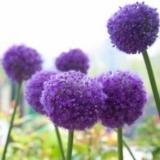
地被菊是多年生宿根草本花卉,属短日照植物,8~9月便形成花蕾,陆续开花(多数品种的自然花期是9~10月)。根系发达,不定根每年复生,萌发新个体,枝叶繁茂,冠形丰满。
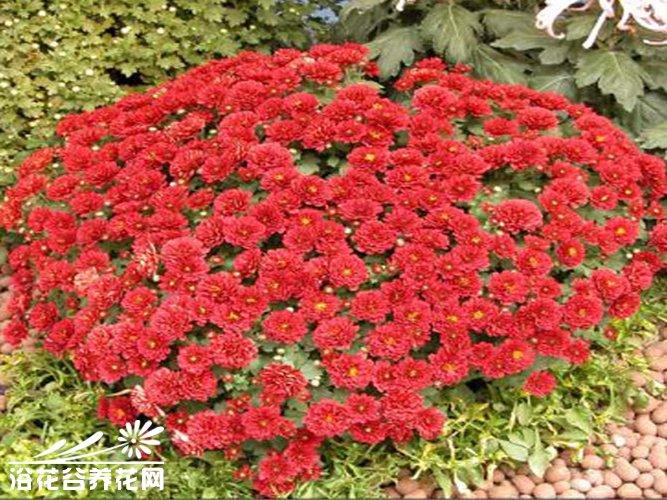
1、 繁殖方法
地被菊的繁殖包括有性繁殖和无性繁殖两种。有性繁殖即播种繁殖,这种方法成本低,繁殖系数大,可获得大量变异种,但后代性状良莠不齐。无性繁殖包括分株、扦插、嫁接等方法。为了保持地被菊的优良特性,通常采用无性繁殖,而其中分株和扦插两种方法是人们常用的繁殖方法。分株繁殖一般选在4月下旬至5月上旬的阴天进行,如连续晴天也可在下午进行。扦插繁殖一般在4~5月份在插床或苗盘中进行,两周后大部分插穗生根,一般在扦插后25~30天定植。
2、 定植及管理
应选择在通风排水良好的沙壤地定植,地被菊喜肥,定植前一定要施足底肥。定植株行距为30cm×40cm,第一年可适当密植,以便及早覆盖地面,第二年应及时间苗。定植时根系要舒展,种植深度为将基部1~2片叶节埋入土中为宜,根部要用土压实,苗要栽正,之后浇透水。在生长前期,要多次松土除草,增强土壤的透气性。为防止雨季积水,当植株长到20cm~30cm高时,可结合施肥进行培土。地被菊缓苗后应及时摘心,只留下部四片叶,以利于多分枝。成活后,一般不再需要浇水施肥。第一年定植,通常不需摘心。第二年因长势强,株距相对变密,易导致徒长,基叶脱落。所以,自第二年起需采取控水、间苗疏枝、摘心等措施。最后一次定头一般不宜迟于7月20日,否则会推迟花期甚至影响开花。地被菊生长期间,要及时摘除残花,修剪生长过密的枝叶和病枯枝,以保证健壮枝的营养供应和保持株型良好。
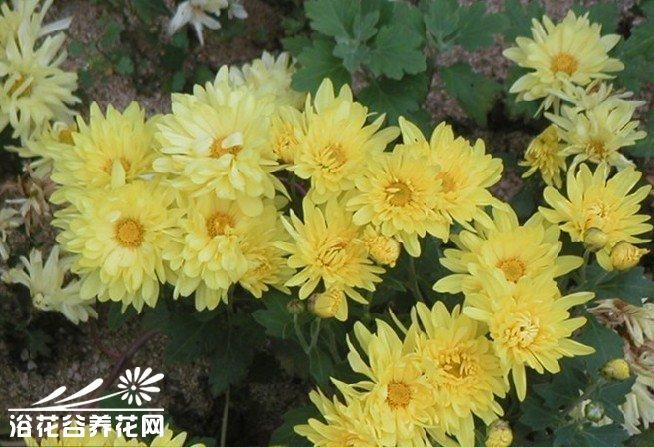
3 、病害防治
在地被菊整个生长过程中,需注意病虫害防治,特别是叶斑病、病毒病、蚜虫、蛴螬等,应结合病情进行适当药物防治。

1、 繁殖方法
地被菊的繁殖包括有性繁殖和无性繁殖两种。有性繁殖即播种繁殖,这种方法成本低,繁殖系数大,可获得大量变异种,但后代性状良莠不齐。无性繁殖包括分株、扦插、嫁接等方法。为了保持地被菊的优良特性,通常采用无性繁殖,而其中分株和扦插两种方法是人们常用的繁殖方法。分株繁殖一般选在4月下旬至5月上旬的阴天进行,如连续晴天也可在下午进行。扦插繁殖一般在4~5月份在插床或苗盘中进行,两周后大部分插穗生根,一般在扦插后25~30天定植。
2、 定植及管理
应选择在通风排水良好的沙壤地定植,地被菊喜肥,定植前一定要施足底肥。定植株行距为30cm×40cm,第一年可适当密植,以便及早覆盖地面,第二年应及时间苗。定植时根系要舒展,种植深度为将基部1~2片叶节埋入土中为宜,根部要用土压实,苗要栽正,之后浇透水。在生长前期,要多次松土除草,增强土壤的透气性。为防止雨季积水,当植株长到20cm~30cm高时,可结合施肥进行培土。地被菊缓苗后应及时摘心,只留下部四片叶,以利于多分枝。成活后,一般不再需要浇水施肥。第一年定植,通常不需摘心。第二年因长势强,株距相对变密,易导致徒长,基叶脱落。所以,自第二年起需采取控水、间苗疏枝、摘心等措施。最后一次定头一般不宜迟于7月20日,否则会推迟花期甚至影响开花。地被菊生长期间,要及时摘除残花,修剪生长过密的枝叶和病枯枝,以保证健壮枝的营养供应和保持株型良好。

3 、病害防治
在地被菊整个生长过程中,需注意病虫害防治,特别是叶斑病、病毒病、蚜虫、蛴螬等,应结合病情进行适当药物防治。
0
0
文章
曹秋柳
2017年05月22日

银苞菊又名贝细工、铁菊、翼枝菊,多年生植物常作二年生栽培,株高约1米,头状花序单生枝顶,直径约2.5厘米;仅具管状花,黄色;总苞苞片卵形,银白色,呈花瓣状。自然花期6~9月。
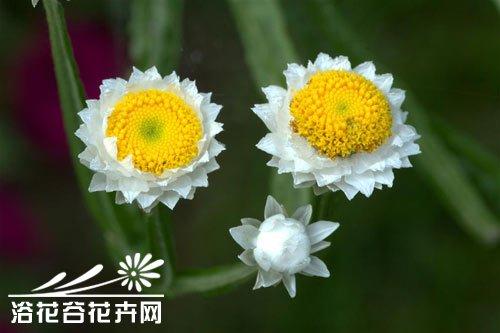
银苞菊喜阳光充足,通风良好的环境,耐旱。对土质要求不很严格,如果有条件宜选用富含腐殖质的砂质壤土。
播种秋季或春季。当小苗高约6厘米时摘心一次,以促发分枝。定植前施足基肥。银苞菊不喜大肥,施肥过多,特别是施用氮肥过多,会使花朵颜色显得不很鲜艳。在植株现蕾前,每隔10天左右追施一次含磷、钾的稀薄液体肥料,直至花蕾透色时。银苞菊比较耐旱,栽培土壤过于潮湿容易导致植株烂根,浇水要做到宁少勿多。雨季注意及时排水。
银苞菊的花朵小巧紧凑、银瓣金芯、颇具特色。因其总苞苞片呈干膜质,为银白色,经采收后阴干可以长期保存,所以特别适合用来作为干花,将其安放在古香古色的瓶器中能够为环境增添田园气息。

银苞菊喜阳光充足,通风良好的环境,耐旱。对土质要求不很严格,如果有条件宜选用富含腐殖质的砂质壤土。
播种秋季或春季。当小苗高约6厘米时摘心一次,以促发分枝。定植前施足基肥。银苞菊不喜大肥,施肥过多,特别是施用氮肥过多,会使花朵颜色显得不很鲜艳。在植株现蕾前,每隔10天左右追施一次含磷、钾的稀薄液体肥料,直至花蕾透色时。银苞菊比较耐旱,栽培土壤过于潮湿容易导致植株烂根,浇水要做到宁少勿多。雨季注意及时排水。
银苞菊的花朵小巧紧凑、银瓣金芯、颇具特色。因其总苞苞片呈干膜质,为银白色,经采收后阴干可以长期保存,所以特别适合用来作为干花,将其安放在古香古色的瓶器中能够为环境增添田园气息。
0
0
文章
stone
2017年05月22日
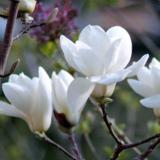
很多花友不知道朱顶红秋季如何管理,在9月以后,朱顶红的生长已经进入后期,秋季是它一年中最后的生长期,通常,过了10月下旬,就会逐渐开始出现冬眠的现象,在气温较低的情况下,会表现为落叶,只留球茎越冬,只有到明年的早春,才会重新发芽。
如果此时球茎直径超过4厘米,则日后开花有希望,平时浇水,不要等土全干,若等土壤全干透后再浇,那么就会因为缺水而影响根系生长,日后会出状况的,至于追肥,看植株情况,酌情补充磷钾肥,促进球茎的生长,为越冬做准备。

其实朱红红秋季管理的重点在于秋冬交替的这一段,温度下降之前,朱顶红依旧正常生长,花友不管是浇水还是施肥都和夏季一样就可以了,而温度降下来之后,朱顶红会进入冬眠状态,看下段。
温度太低朱顶红进入休眠状态或者自然的新陈代谢,朱顶红的叶片会黄化枯萎,这时候可以不需要人工提前去剪除,因为球根花卉有一个特性,在叶片枯萎的同时,会有一部分养分从新输送回种球里面。如果提前去掉叶片,就是浪费了很大一部分养分。等叶子完全枯萎了再去掉即可。
知识延伸,冬季朱顶红该如何养护?
朱顶红在越冬期间,如果不选择起球,留在盆中养,则浇水依旧是必须的,只不过频率上要适当减少,看表土情况而不是根据多少天一次。浇水的目的是为了保持球茎的硬挺。在盆栽朱顶红自然落叶的时候,尽量让叶子晚一些枯萎,因为叶子变黄之前,留存在植株上的时间越长,就越对球茎生长有帮助。
朱顶红的休眠期间注意一点:浇水依旧是必须的,断肥不断水,照常粗放对待,保温最重要。
如果此时球茎直径超过4厘米,则日后开花有希望,平时浇水,不要等土全干,若等土壤全干透后再浇,那么就会因为缺水而影响根系生长,日后会出状况的,至于追肥,看植株情况,酌情补充磷钾肥,促进球茎的生长,为越冬做准备。

其实朱红红秋季管理的重点在于秋冬交替的这一段,温度下降之前,朱顶红依旧正常生长,花友不管是浇水还是施肥都和夏季一样就可以了,而温度降下来之后,朱顶红会进入冬眠状态,看下段。
温度太低朱顶红进入休眠状态或者自然的新陈代谢,朱顶红的叶片会黄化枯萎,这时候可以不需要人工提前去剪除,因为球根花卉有一个特性,在叶片枯萎的同时,会有一部分养分从新输送回种球里面。如果提前去掉叶片,就是浪费了很大一部分养分。等叶子完全枯萎了再去掉即可。
知识延伸,冬季朱顶红该如何养护?
朱顶红在越冬期间,如果不选择起球,留在盆中养,则浇水依旧是必须的,只不过频率上要适当减少,看表土情况而不是根据多少天一次。浇水的目的是为了保持球茎的硬挺。在盆栽朱顶红自然落叶的时候,尽量让叶子晚一些枯萎,因为叶子变黄之前,留存在植株上的时间越长,就越对球茎生长有帮助。
朱顶红的休眠期间注意一点:浇水依旧是必须的,断肥不断水,照常粗放对待,保温最重要。
1
0
文章
笼岛 みどり
2017年05月22日


8月8日の誕生花
8月8日の誕生花は、「#クレオメ 」です。
南アフリカ原産のフウチョウソウ科フウチョウ属の一年草です。花期は7~9月で、草丈は80~120㎝位に伸び、頂点に桃色や白、紫のたくさんの4弁花を咲かせます。つぼみは濃い桃色ですが、咲くと淡い桃色に、さらに時間が経過すると白色に変化します。花のひとつひとつの寿命は短いですが、毎日新しい花が開いていくので長い間花を楽しめます。
クレオメについて科・属 フウチョウソウ科フウチョウソウ属英名 Spider flower学名 Cleome spinosa原産地 南アメリカ開花時期 7月~10月花名の由来
クレオメの咲いている花姿がチョウが飛んでいるように見えることから和名では「西洋風蝶草」とよばれます。英語では蜘蛛の花を意味する「Spider flower」と呼ばれ、これはチョウではなく細く長い蜘蛛の足に例えています。
クレオメの花言葉と由来
クレオメの花言葉は、「秘密のひととき」「想像したほど悪くない」「あなたの容姿に酔う」「風に舞う胡蝶」。
「秘密のひととき」という花言葉は、クレオメは夕方頃になったら花が開き、次の日になるとしおれてしまっている「一日花」であることから、人の眠っている夜の間にひっそりと咲くことに由来しているようです。
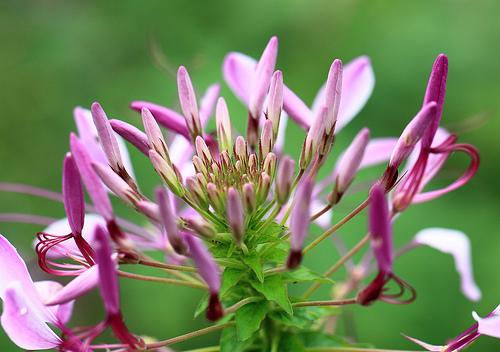
クレオメの豆知識意外と流通しない
こぼれダネでよく増えるのにもかかわらず意外と流通していません。流通量が少ないのもあって、ちょっと苗が高くなっています。それでもネットショップで寄せたほうがよさそうです。
他の花言葉の記事はここから探してみよう。
0
0
文章
曹秋柳
2017年05月22日

雏菊为菊科雏菊属多年生草本植物,较耐寒,常做二年生栽培,有的花友想种,但是苦于不知道雏菊种子怎么种植,其实雏菊种子种植并没有那么难。
雏菊种子种植主要在每年的8~9月间进行(这个时间是相对最佳,因为见过有花友10月份播种、5月份播种,都成功了),播种后12-14周开花。播种宜选用疏松、透气的介质。最好再用蛭石(其他介质覆盖也可以)覆盖,薄薄一层,以不见种子为度。
因雏菊种子很小,不宜点播,所以一般用撒播,当苗长有2-3片真叶即可移植一次。播后保持18-20℃的温度,80-90%的湿度,5-8天发芽。在江浙一带还可春播,但育苗长势和开花都不如秋播苗。所以一般不用春播。

#雏菊的日常养护:
光照调节:雏菊也喜阳光,包括在生长期和开花期。光照充分可促进植株的生长,叶色嫩绿,花量增加。
温度控制:上盆后移至保护地越冬,可防止盆花在冬天受冻害。
以上可安全越冬,保持18-22℃的温度对良好植株的形成是最适宜的。而在实际中很难做到。雏菊10-25℃可正常开花,温度低于10℃时,生长相对缓慢,株形减小,开花延迟。如温度高于25℃,花茎会拉长,生长势及开花都会衰减。在5-6月份,气温升高,生长势及开花不够理想,所以一般都用秋播苗来避开5月份以后的气温升高环境。
水肥管理:雏菊喜肥沃土壤,单靠其介质中的基肥是不能满足其生长需要的。所以每隔7-10天追一次肥,可用20-10-20和14-0-14的花卉肥,也可用复合肥进行点施或溶于水浇灌,浓度在200-250ppm。但复合肥点施不如浇灌见效快。所以有条件的可用20-10-20和14-0-14的水溶性花卉肥交替使用。但在冬天应减少20-10-20的用肥量,在浇水肥前应让介质稍干,湿润但不能潮湿。因其是基叶簇生,如不通风,基部叶片很容易腐烂,感染病菌。生长季节给予充足的水肥,长得既茂盛又可延长花期。
栽培管理:雏菊较耐移植,移植可使其多发根。不需作株形修剪和打顶来控制花期。
病虫害:雏菊的主要病害有苗期猝倒病、灰霉病、褐斑病、炭疽病、霜霉病(可用百菌清800-1000倍,甲箱灵1000-1500倍进行防治);虫害有蚜虫等。
雏菊种子种植主要在每年的8~9月间进行(这个时间是相对最佳,因为见过有花友10月份播种、5月份播种,都成功了),播种后12-14周开花。播种宜选用疏松、透气的介质。最好再用蛭石(其他介质覆盖也可以)覆盖,薄薄一层,以不见种子为度。
因雏菊种子很小,不宜点播,所以一般用撒播,当苗长有2-3片真叶即可移植一次。播后保持18-20℃的温度,80-90%的湿度,5-8天发芽。在江浙一带还可春播,但育苗长势和开花都不如秋播苗。所以一般不用春播。

#雏菊的日常养护:
光照调节:雏菊也喜阳光,包括在生长期和开花期。光照充分可促进植株的生长,叶色嫩绿,花量增加。
温度控制:上盆后移至保护地越冬,可防止盆花在冬天受冻害。
以上可安全越冬,保持18-22℃的温度对良好植株的形成是最适宜的。而在实际中很难做到。雏菊10-25℃可正常开花,温度低于10℃时,生长相对缓慢,株形减小,开花延迟。如温度高于25℃,花茎会拉长,生长势及开花都会衰减。在5-6月份,气温升高,生长势及开花不够理想,所以一般都用秋播苗来避开5月份以后的气温升高环境。
水肥管理:雏菊喜肥沃土壤,单靠其介质中的基肥是不能满足其生长需要的。所以每隔7-10天追一次肥,可用20-10-20和14-0-14的花卉肥,也可用复合肥进行点施或溶于水浇灌,浓度在200-250ppm。但复合肥点施不如浇灌见效快。所以有条件的可用20-10-20和14-0-14的水溶性花卉肥交替使用。但在冬天应减少20-10-20的用肥量,在浇水肥前应让介质稍干,湿润但不能潮湿。因其是基叶簇生,如不通风,基部叶片很容易腐烂,感染病菌。生长季节给予充足的水肥,长得既茂盛又可延长花期。
栽培管理:雏菊较耐移植,移植可使其多发根。不需作株形修剪和打顶来控制花期。
病虫害:雏菊的主要病害有苗期猝倒病、灰霉病、褐斑病、炭疽病、霜霉病(可用百菌清800-1000倍,甲箱灵1000-1500倍进行防治);虫害有蚜虫等。
1
4
文章
笼岛 みどり
2017年05月22日


8月10日の誕生花
8月10日の誕生花は、「#ルコウソウ(縷紅草) 」です。
原産地は南アメリカ、ヒルガオ科ルコウソウ属のつる性の多年草です。開花期は6~9月で、細い筒状で直径2cmほどの星型の5つに裂けた真紅の花をつけます。葉は糸のように細く、つる性という性質を利用してグランドカバーとして使ったり、ネットに絡ませてグリーンカーテンとしても使われます。
ルコウソウ(縷紅草)について科・属 ヒルガオ科ルコウソウ属英名 Cypress vine、Star Glory学名 Ipomoea quamoclit原産地 南アメリカ開花時期 6~9月花名の由来
漢字で「縷紅草」と書くルコウソウは、細い糸という意味のある「縷」に花色の紅があわさって、「細い糸のような葉をもった紅色の花をつける植物」という意味があります。別名南瓜朝顔(かぼちゃあさがお)と呼びますが、カボチャではなく、カンボジアから伝わったため、カンボジアの意味のことです。
ルコウソウ(縷紅草)の花言葉と由来
ルコウソウ(縷紅草)の花言葉は、「繊細な愛」「おせっかい」「でしゃばり」「常に愛らしい」「元気」「私は忙しい」「多忙」。
花の可愛さから常に愛らしいといった意味がありますが、つる性で繁殖力が強いことから、おせっかい、でしゃばりといった良くない意味が多くあります。良くない意味が殆どなので、贈ると相手を傷つけてしまう可能性があるので、贈らないようにしましょう。

他の花言葉の記事はここから探してみよう。
0
0
文章
Hande Salcan
2017年05月22日

Learn how to grow prickly pear cactus in this article. Growing prickly pear cactus and its care is not difficult, if you grow it in right growing conditions.
USDA Zones— 9 – 11
Difficulty— Easy

Other Names— Barbary-fig Cactus, Cactus Pear Fruit, Gracemere-Pear, Indian-fig, Indian fig, Nopal Cactus, Oponce, Opuntia, Opuntia cardona, Opuntia ficus, Opuntia ficus-indica, Opuntia fuliginosa, Opuntia hyptiacantha, Opuntia lasciacantha, Opuntia macrocentra, Opuntia megacantha, Opuntia puberula, Opuntia streptacantha, Opuntia velutina, Opuntia violacea, Tuna Cardona, Westwood-Pear.
Also known as Indian fig, prickly pear is a common succulent plant in Mediterranean and subtropical regions. It is grown as an ornamental plant and for its juicy fruits. Prickly pear cactus is undemanding and easy to grow. It grows about 1 – 2.5 m high. The flowers are very showy, colors ranging from white, yellow, to orange, depending more on the variety.How to Grow Prickly Pear CactusPropagation
Prickly pear cactus can be propagated from seeds or pads. Growing prickly pear from the pad is comparatively easy than seeds. To facilitate the rooting, it is preferable to wait until the cuts are perfectly healed (about 1 – 2 week) before planting. Tuck them an inch deep on the ground or in containers. The rooting takes place in a short time, usually in a month. Save the rooting pad from afternoon sun and water it when top one inch of soil seems dry.
Location
Growing prickly pear cactus in a sunny location allows the plant to thrive and fruit. Prickly pear cactus is a tropical or subtropical plant, so it loves the warm exposure. However, it can withstand temperatures down to 14 F (-10 C), but in areas, with harsh winters it is best to plant it in a sheltered spot, near a wall or tall tree to protect it from cold drafts and fluctuation in temperature. If you’re living in a cooler climate, growing prickly pear cactus in a container is the better option for you as it can only be grown on the ground where winter temperature remains above 14 F (- 10 C).
Requirements for Growing Prickly Pear CactusSoil
Grow it in well-drained, sandy and loamy soil, avoid clay-rich soil that is not well draining and remains moist. For growing prickly pear cactus in a container use potting mix or 1/3 part each of compost, soil, and coarse sand or perlite.
Watering
Watering should be done only when the surface looks dry. On average, during the spring and summer, water it once or twice a week and during the fall and winter once or twice a month. If you’re living in tropics more frequent watering will be required.
Repotting
If growing in a pot, the plant must be repotted once it is root bound. Whenever you identify that the plant is growing slowly, repot it. The best repotting time is spring.
Prickly Pear Cactus Care
Prickly pear cactus care involves several steps that are given below.
Fertilizer
From spring to fall, fertilize every month with a liquid 5-10-10 fertilizer to promote flowering and fruiting. For the young plant, fertilize with 10-10-10 fertilizer. Do not feed in winter in cooler zones when plant stops to grow.
Pruning
Pruning is done in spring or late summer by removing the pads that come into contact with each other or those that are damaged or poorly formed.
Overwintering
Prickly pear cactus care in winter is essential. If you’re growing prickly pear cactus in a pot, protect it in winter by keeping it indoors. If growing outside, do mulching to insulate the plant from temperature drop.
Fruit thinning
Fruit thinning is done to get a better harvest. It is necessary to remove extra fruits and flowers to get lower production but of improved quality. It is recommended that thinning must be done two weeks before the formation of the fruits, leaving approximately up to 10 fruits per stalk.
Pests and Diseases
Mealybugs, spider mites, and cochineal might attack it. It is also attacked by fruit flies and moths.
Too much water or cold causes rotting. As soon as you detect the softening of tissues, remove the rotten part and treat the infected part with fungicide.
Harvesting
USDA Zones— 9 – 11
Difficulty— Easy

Other Names— Barbary-fig Cactus, Cactus Pear Fruit, Gracemere-Pear, Indian-fig, Indian fig, Nopal Cactus, Oponce, Opuntia, Opuntia cardona, Opuntia ficus, Opuntia ficus-indica, Opuntia fuliginosa, Opuntia hyptiacantha, Opuntia lasciacantha, Opuntia macrocentra, Opuntia megacantha, Opuntia puberula, Opuntia streptacantha, Opuntia velutina, Opuntia violacea, Tuna Cardona, Westwood-Pear.
Also known as Indian fig, prickly pear is a common succulent plant in Mediterranean and subtropical regions. It is grown as an ornamental plant and for its juicy fruits. Prickly pear cactus is undemanding and easy to grow. It grows about 1 – 2.5 m high. The flowers are very showy, colors ranging from white, yellow, to orange, depending more on the variety.How to Grow Prickly Pear CactusPropagation
Prickly pear cactus can be propagated from seeds or pads. Growing prickly pear from the pad is comparatively easy than seeds. To facilitate the rooting, it is preferable to wait until the cuts are perfectly healed (about 1 – 2 week) before planting. Tuck them an inch deep on the ground or in containers. The rooting takes place in a short time, usually in a month. Save the rooting pad from afternoon sun and water it when top one inch of soil seems dry.
Location
Growing prickly pear cactus in a sunny location allows the plant to thrive and fruit. Prickly pear cactus is a tropical or subtropical plant, so it loves the warm exposure. However, it can withstand temperatures down to 14 F (-10 C), but in areas, with harsh winters it is best to plant it in a sheltered spot, near a wall or tall tree to protect it from cold drafts and fluctuation in temperature. If you’re living in a cooler climate, growing prickly pear cactus in a container is the better option for you as it can only be grown on the ground where winter temperature remains above 14 F (- 10 C).
Requirements for Growing Prickly Pear CactusSoil
Grow it in well-drained, sandy and loamy soil, avoid clay-rich soil that is not well draining and remains moist. For growing prickly pear cactus in a container use potting mix or 1/3 part each of compost, soil, and coarse sand or perlite.
Watering
Watering should be done only when the surface looks dry. On average, during the spring and summer, water it once or twice a week and during the fall and winter once or twice a month. If you’re living in tropics more frequent watering will be required.
Repotting
If growing in a pot, the plant must be repotted once it is root bound. Whenever you identify that the plant is growing slowly, repot it. The best repotting time is spring.
Prickly Pear Cactus Care
Prickly pear cactus care involves several steps that are given below.
Fertilizer
From spring to fall, fertilize every month with a liquid 5-10-10 fertilizer to promote flowering and fruiting. For the young plant, fertilize with 10-10-10 fertilizer. Do not feed in winter in cooler zones when plant stops to grow.
Pruning
Pruning is done in spring or late summer by removing the pads that come into contact with each other or those that are damaged or poorly formed.
Overwintering
Prickly pear cactus care in winter is essential. If you’re growing prickly pear cactus in a pot, protect it in winter by keeping it indoors. If growing outside, do mulching to insulate the plant from temperature drop.
Fruit thinning
Fruit thinning is done to get a better harvest. It is necessary to remove extra fruits and flowers to get lower production but of improved quality. It is recommended that thinning must be done two weeks before the formation of the fruits, leaving approximately up to 10 fruits per stalk.
Pests and Diseases
Mealybugs, spider mites, and cochineal might attack it. It is also attacked by fruit flies and moths.
Too much water or cold causes rotting. As soon as you detect the softening of tissues, remove the rotten part and treat the infected part with fungicide.
Harvesting
0
0
文章
Hande Salcan
2017年05月22日

Learn how to grow calamansi in this guide. Growing calamansi is rewarding. Its exotic citrus like fragrance and mix of tangy, sweet flavor of lime and tangerine of its fruit makes it a worth fruit tree.

USDA Hardiness Zones — 9 – 11, *can be grown in containers in cooler zones
Difficulty — Moderate
Other Names — calamonding, calamondin orange, calamansi, calamandarin, golden lime, kalamunding, kalamansi, Philippine lime, Panama orange, Chinese orange, musk orange and acid orange.
Family — Rutaceae
Genus — Citrofortunella
Temperature— 60 – 90 F is optimum growing temperature
Propagation Method — Seeds, cuttings
About Calamansi
Calamansi is a tropical fruit of citrus variety, sized between orange and lime. This small fruit tree grows mostly in South East Asia. It is mostly grown for ornamental purposes in other parts of the world. Calamansi bears smaller fruits than orange which are sour, a little bit sweeter and juicy in taste.
Growing Condition
Calamansi tree grows in warm tropical and subtropical climate. The growing conditions are similar to that of other citrus trees.
Requirements for Growing CalamansiSun
Growing calamansi in full sun is required for healthy growth. Proper exposure to sun and temperature improves productivity.
Soil
Calamansi grows well in dry soil that doesn’t retain moisture and remains waterlogged.
Watering
Water deeply but only when the top layer of soil dries out, calamansi plant doesn’t like wet feet.
How to Plant Calamansi
If your climate is frost free and remains warm throughout the year, plant it outside. If you live below USDA Zone 9b, it is better to plant it in a container.
Calamnsi CareFertilizer
Fertilize your calamansi plant every other month during the growing period with liquid fertilizer that is rich in nitrogen and potassium.
Harvest
It starts to bear fruits after two-three years of growing calamansi plant and produce them throughout the year intermittently (*in tropics). You can either harvest them young when the color of peel looks variegated pale green or wait until they fully ripen and resemble orange like color.
Pests and Diseases

USDA Hardiness Zones — 9 – 11, *can be grown in containers in cooler zones
Difficulty — Moderate
Other Names — calamonding, calamondin orange, calamansi, calamandarin, golden lime, kalamunding, kalamansi, Philippine lime, Panama orange, Chinese orange, musk orange and acid orange.
Family — Rutaceae
Genus — Citrofortunella
Temperature— 60 – 90 F is optimum growing temperature
Propagation Method — Seeds, cuttings
About Calamansi
Calamansi is a tropical fruit of citrus variety, sized between orange and lime. This small fruit tree grows mostly in South East Asia. It is mostly grown for ornamental purposes in other parts of the world. Calamansi bears smaller fruits than orange which are sour, a little bit sweeter and juicy in taste.
Growing Condition
Calamansi tree grows in warm tropical and subtropical climate. The growing conditions are similar to that of other citrus trees.
Requirements for Growing CalamansiSun
Growing calamansi in full sun is required for healthy growth. Proper exposure to sun and temperature improves productivity.
Soil
Calamansi grows well in dry soil that doesn’t retain moisture and remains waterlogged.
Watering
Water deeply but only when the top layer of soil dries out, calamansi plant doesn’t like wet feet.
How to Plant Calamansi
If your climate is frost free and remains warm throughout the year, plant it outside. If you live below USDA Zone 9b, it is better to plant it in a container.
Calamnsi CareFertilizer
Fertilize your calamansi plant every other month during the growing period with liquid fertilizer that is rich in nitrogen and potassium.
Harvest
It starts to bear fruits after two-three years of growing calamansi plant and produce them throughout the year intermittently (*in tropics). You can either harvest them young when the color of peel looks variegated pale green or wait until they fully ripen and resemble orange like color.
Pests and Diseases
1
0
文章
Micky
2017年05月22日

Learn how to grow Ginko Biloba tree, growing ginkgo biloba tree is easy. This beautiful ornamental tree will soon become one of the most beautiful trees in your garden, once established.

USDA zones — 4-9
Other Names — Fossil Tree, Maidenhair Tree, Japanese Silver Apricot, Baiguo, Bai Guo Ye, Kew Tree, Yinhsing, The Tree of Forty Crowns
Difficulty — Easy
How to Grow Ginkgo Biloba Propagation
Ginkgo tree can be propagated from seeds or by cuttings.
Propagation from cuttings is better. To propagate it from cuttings, cut around 10 cm long cutting and plant it in a pot with potting soil lightened with perlite.
Cover it with plastic sheet and water regularly. After cutting has rooted, slowly acclimatize it without the sheet and transplant it into bigger pot or on the ground when it has outgrown the current pot.
Also Read: Ginkgo Biloba Tree Facts
Planting Ginkgo Biloba Tree
Female trees form fleshy fruits and their smell quickly becomes nauseating. Ether avoid planting them or plant them away from your home.
Plant ginkgo tree in the fall or spring. Prepare planting hole that is of the same depth and twice wide of the rootball. Bury the rootball in hole and water thoroughly. Protect young plants from drought and harsh sun.
Requirements for Growing Ginkgo Biloba TreePosition
It has good tolerance to the temperate climate and can withstand a semi-continental condition. It needs full sun or very light shade. It is also resistant to winds.
Soil
No specific soil type is required for growing ginkgo biloba tree. However, soil should be well drained but in a way that it must not dry out quickly, also note that the tree grows long taproot and requires deep soil.
It is best to plant it in light, rich soil. It supports mildly calcareous soil but prefers neutral, silty and slightly clayey soil. Add sand if needed to alleviate the heavy clay rich soil and compost to amend the poor substrate.
Watering
Water Ginkgo biloba tree regularly until it establishes in the first 3 years of growth. Keeping the soil moist as its growth is slower in dry soil but avoid damp and heavy soil.
Ginkgo Biloba Tree CareFertilizer
Generally, fertilizer is not required but to give a boost you can fertilize it in spring using a slow-release balanced fertilizer containing nitrogen, phosphorus and potassium (N-P-K), according to the label instructions. A balanced 10-10-10 fertilizer is suitable. Annual application of compost or manure is also helpful for plant.
Mulching
Mulching is essential for growing ginkgo biloba tree. In summer to preserve moisture and in winter to protect the roots from the cold.
Pruning
Ginkgo biloba is a beautiful tree, it does not require additional pruning unless you want to control its shape or size.
Pests and Diseases

USDA zones — 4-9
Other Names — Fossil Tree, Maidenhair Tree, Japanese Silver Apricot, Baiguo, Bai Guo Ye, Kew Tree, Yinhsing, The Tree of Forty Crowns
Difficulty — Easy
How to Grow Ginkgo Biloba Propagation
Ginkgo tree can be propagated from seeds or by cuttings.
Propagation from cuttings is better. To propagate it from cuttings, cut around 10 cm long cutting and plant it in a pot with potting soil lightened with perlite.
Cover it with plastic sheet and water regularly. After cutting has rooted, slowly acclimatize it without the sheet and transplant it into bigger pot or on the ground when it has outgrown the current pot.
Also Read: Ginkgo Biloba Tree Facts
Planting Ginkgo Biloba Tree
Female trees form fleshy fruits and their smell quickly becomes nauseating. Ether avoid planting them or plant them away from your home.
Plant ginkgo tree in the fall or spring. Prepare planting hole that is of the same depth and twice wide of the rootball. Bury the rootball in hole and water thoroughly. Protect young plants from drought and harsh sun.
Requirements for Growing Ginkgo Biloba TreePosition
It has good tolerance to the temperate climate and can withstand a semi-continental condition. It needs full sun or very light shade. It is also resistant to winds.
Soil
No specific soil type is required for growing ginkgo biloba tree. However, soil should be well drained but in a way that it must not dry out quickly, also note that the tree grows long taproot and requires deep soil.
It is best to plant it in light, rich soil. It supports mildly calcareous soil but prefers neutral, silty and slightly clayey soil. Add sand if needed to alleviate the heavy clay rich soil and compost to amend the poor substrate.
Watering
Water Ginkgo biloba tree regularly until it establishes in the first 3 years of growth. Keeping the soil moist as its growth is slower in dry soil but avoid damp and heavy soil.
Ginkgo Biloba Tree CareFertilizer
Generally, fertilizer is not required but to give a boost you can fertilize it in spring using a slow-release balanced fertilizer containing nitrogen, phosphorus and potassium (N-P-K), according to the label instructions. A balanced 10-10-10 fertilizer is suitable. Annual application of compost or manure is also helpful for plant.
Mulching
Mulching is essential for growing ginkgo biloba tree. In summer to preserve moisture and in winter to protect the roots from the cold.
Pruning
Ginkgo biloba is a beautiful tree, it does not require additional pruning unless you want to control its shape or size.
Pests and Diseases
1
0
文章
Micky
2017年05月22日


Learn how to grow pecan trees. Planting and growing pecan trees is easy but it requires lot of space as the tree grows tall and wide.
USDA Zones— 5 to 9
Difficulty— Easy
Scientific Name— Carya illinoinensis
Pecan Tree Information
Pecan trees are native to America and Mexico and grow mostly in Georgia and grows in Florida to Illinois, even to the west of Texas. Pecan trees are rather large, a mature pecan tree can grow up to 40 m tall with a spread of 12 – 20 m. If you’ve large yard you can grow pecan trees as they are not suitable for small backyards or garden. These trees are the source of many medium-sized pecans that are eaten fresh or used to create sweet desserts and candies, including pecan pie, caramel-pecan tarts, pecan pie, pecan pralines and many others.
Planting Pecan TreesBefore planting remove all the dead and entangled roots and prune off 1/2 part of the plant. This will encourage the vigorous growth and healthy roots.Space candy pecan no closer than 40 feet (if planting in a garden). For planting pecan trees in orchard, a suitable distance is 40 – 50 feet.Grow at least two pecan trees to ensure that most of flowers produce nuts. Although self-pollination in candy pecan is possible, but it is preferred that at least two or three trees are planted nearby for maximum nut production.For planting pecan tree, dig a hole at least 2 feet wide and 2 feet deep as pecan trees have extensive root system. Fill the hole with well-drained soil. Pecan trees can generally be grown easily and efficiently in a variety of soil types, except the soil which drains poorly.Requirements for Growing Pecan TreesLocation
Location should be sunny and open as pecan tree spreads a lot and grow taller.
Soil
Growing pecan trees is possible in variety of soil types, but for optimum growth soil should be well drained, deep and rich in organic matter with pH level slightly acidic to neutral.
Water
Pecan tree grows in slightly moist soil. Regular and deep watering is important for growing pecan trees. In first three years water deeply, once a week (avoid during rain), reduce watering in winter. During fruit production watering should be increased.
Pecan Tree CareFertilizer
In the spring fertilize it with compost or farm manure, also apply fertilizer that is rich in potassium and phosphorus around the tree, 5-10-15 is suitable. After first year of planting, apply balanced fertilizer in spring and in summer use zinc sulphate, which is essential for healthy growth and production of pecan trees.
Mulching
Mulching is important for pecan trees as they require evenly moist soil, mulching also reduces the competitive weeds.
Harvest
A grafted tree start to produce fruit in 3 to 4 years after planting. It is an alternate fruit bearing tree, it means it bears heavy fruit one year and light in the next year. Pecan trees bear fruits in fall and are ready to harvest when the husk loose its green color and start to split.
Pecan Tree Diseases and Pests
0
0
文章
Micky
2017年05月22日

Whether you’re growing sassafras tree or not, read these sassafras tree facts.
Sassafras tree grows in the United States and in south of Mexico. In the northern US, the tree grows up to only 7 to 9 m. high, but can grow as tall as 30 m. (100 feet) high in the south. Its shredded leaves and bark exude lemony scent. Fuzzy, yellow-green leaves, flowers, bark and roots have many medicinal and culinary uses. Read more sassafras tree facts below.

Polymorphic leave
Polymorphic is a botanical term used to describe the leaves of trees such as sassafras. This means that on a tree, even on a branch, leaves of different shapes exist. Sassafras tree leaves often grow in three shapes: three-lobed, mitten-shaped and elliptical or egg-shaped. Most of the time there are just three lobes on the leaves, but up to seven are possible.
Size and color
Sassafras tree leaves are not particularly large, measuring between 3 and 7 inches long and up to 4 inches wide. The upper surface of the sassafras leaves is of bright green color, but the lower part of the leaves is considerably less bright, with an almost white appearance.
Fall colors of sassafras leaves are a major asset for the tree as a landscaping tool. Often spectacular, the leaves turn purple, orange, yellow and red.
When sassafras leaves are crushed or rubbed, they emit a pungent aroma. The petiole from where leaf attaches to the branch on a sassafras tree is long and thin.
Attractive to wildlife
Sassafras tree is also attractive for many wild creatures. Butterfly caterpillars and deer likes to eat its leaves. In winter rabbits considers sassafras bark a delicious treat.
Fruits are eaten by many birds, including: Great Crested Flycatchers, Wild Turkey, Pileated Woodpeckers, Flickers, and Northern Mockingbirds. Small mammals also eat the fruit.
More Sassafras Tree Facts
Sassafras trees are known to repel mosquitoes and other insects.
The tree is designated as an ornamental tree because of its strange shaped leaves.
The rich flavor from sassafras roots have also been put in soups and stews for an unusual extra flavor.
The roots and bark of the sassafras tree was used to make oil.
Some soaps, lotions and flavors of medicine have been adding this tree oil for an unusual, perhaps somewhat exotic, smell or taste.
Also Read: How to grow sassafras
Sassafras tree grows in the United States and in south of Mexico. In the northern US, the tree grows up to only 7 to 9 m. high, but can grow as tall as 30 m. (100 feet) high in the south. Its shredded leaves and bark exude lemony scent. Fuzzy, yellow-green leaves, flowers, bark and roots have many medicinal and culinary uses. Read more sassafras tree facts below.

Polymorphic leave
Polymorphic is a botanical term used to describe the leaves of trees such as sassafras. This means that on a tree, even on a branch, leaves of different shapes exist. Sassafras tree leaves often grow in three shapes: three-lobed, mitten-shaped and elliptical or egg-shaped. Most of the time there are just three lobes on the leaves, but up to seven are possible.
Size and color
Sassafras tree leaves are not particularly large, measuring between 3 and 7 inches long and up to 4 inches wide. The upper surface of the sassafras leaves is of bright green color, but the lower part of the leaves is considerably less bright, with an almost white appearance.
Fall colors of sassafras leaves are a major asset for the tree as a landscaping tool. Often spectacular, the leaves turn purple, orange, yellow and red.
When sassafras leaves are crushed or rubbed, they emit a pungent aroma. The petiole from where leaf attaches to the branch on a sassafras tree is long and thin.
Attractive to wildlife
Sassafras tree is also attractive for many wild creatures. Butterfly caterpillars and deer likes to eat its leaves. In winter rabbits considers sassafras bark a delicious treat.
Fruits are eaten by many birds, including: Great Crested Flycatchers, Wild Turkey, Pileated Woodpeckers, Flickers, and Northern Mockingbirds. Small mammals also eat the fruit.
More Sassafras Tree Facts
Sassafras trees are known to repel mosquitoes and other insects.
The tree is designated as an ornamental tree because of its strange shaped leaves.
The rich flavor from sassafras roots have also been put in soups and stews for an unusual extra flavor.
The roots and bark of the sassafras tree was used to make oil.
Some soaps, lotions and flavors of medicine have been adding this tree oil for an unusual, perhaps somewhat exotic, smell or taste.
Also Read: How to grow sassafras
0
0
文章
笼岛 みどり
2017年05月22日


7月20日の誕生花
7月20日の誕生花は、「ひまわり(向日葵)」です。北アメリカが原産のキク科の1年草で、野生のものは60種ほどあると言われています。7~9月に茎先に20~30㎝ほどの、黄色の大きな花を横向きに咲かせます。
ひまわり(向日葵)について科・属 キク科ヒマワリ属和名向日葵(ヒマワリ)英名 Sunflower学名 Helianthus annuus原産地 北アメリカ開花時期 6月~8月
ひまわり(向日葵)の花言葉と由来
ひまわり(向日葵)の花言葉は、「あこがれ」「あなただけを見つめる」「敬慕」。
ひまわりは、太陽が移動することによってひまわりも花の向きが変わるということから、「日廻り(ひまわり)」と呼ばれていました。学名の「Helianthus」には「太陽の花」という意味があります。
「向日葵」は、ひまわりの花に向日性があることからつけられた「向日」に、「太陽に向かって成長する植物」という意味のある「葵」がつき、「向日葵」とかいて「ひまわり」と呼ばれるようになりました。
花言葉の、「あなただけを見つめる」「あこがれ」は、成長期の頃の花が太陽の動きに合わせるように向きを変えるところから来ています。「敬慕」は、ギリシャ神話の海の精クリティのアポロンへの気持ちを表したと言われています。

ひまわり(向日葵)の種
ひまわりの種は、1.5cmくらいの大きさで、1輪につき500個から3000個ほどの種が出来ます。ひまわりの種といえばハムスターが食べるイメージがありますが、とても栄養が豊富で海外では食用としても人気があります。日本でも、炒って殻が取り除かれたものが販売されています。
ひまわりの種には、リノール酸、葉酸、ビタミン、鉄分、繊維、亜鉛、マグネシウム、カルシウムなどが豊富に含まれていて、とても栄養価が高く、アメリカなどでは長寿や若返りのナッツとして知られているようです。しかし、ナッツは高カロリーなので食べすぎには注意です。
ギリシャ神話のひまわり(向日葵)
ゼウスの息子の太陽神アポロンはまばゆい金髪と美しい顔をもち、類い稀なる竪琴と笛の名手でした。水の精クリュティエは、アポロンに恋こがれますが、叶わぬ恋になってしまいます。それが悲しくてクリュティエは泣いてばかりでした。
クリュティエは、日輪車で東の空に昇ってくるアポロンを待ちつづけ、現れてから西の空に見えなくなるまで目で追い続けました。クリュティエは9日9晩アポロンを見続け、そうしているうちに足は地面に根付き、顔はひまわりの花に変化してしまったといわれています。

他の花言葉の記事はここから探してみよう。LOVEGREEN 花言葉記事一覧
0
0
文章
笼岛 みどり
2017年05月22日


7月9日の誕生花
7月9日の誕生花は、「ギボウシ」です。
山間の湿地などに自生し、東アジアに約20~40種分布しています。花期は6~9月で、まっすぐ伸びた花茎に、白や紫のほっそりとしたろうと状の花を次々と咲かせます。
ギボウシについて科・属 ユリ科・ギボウシ属英名 Hosta,Plantain lily学名 Hosta原産地 東アジア開花時期 6~9月
ギボウシの花言葉と由来
ギボウシの花言葉は、「静かな人」「沈静」。
花の蕾の形が橋の欄干にある擬宝珠に似ていることから名付けられました。また、別名の「ホスタ」は、オーストラリアの植物学者「N.T.Host」と「J.Host」の名前からきているそうです。
花言葉の「沈静」は、たくさんつぼみをつけた花茎に、次々と花が咲いていく姿が静かに佇んでいるかのように見える事からつけられています。「静かな人」は、少し寂しそうな風情が花の形にある事からだと言われています。

カラーリーフとして人気のギボウシ
ギボウシの葉は、緑色だけでなく少し色味の違うものや、縁どりや筋のように斑がはいっているものなど、多くの種類があります。ガーデンのグリーンに色味を加える植物として、とても人気があります。

万能植物、ギボウシ
ギボウシは、たくさんの色があるというだけでなく日陰でも育つ耐陰性植物ですので、日の当たりにくい「シェードガーデン」でもよく育ちますし、また「グランドカバー」
としても利用できます。冬の間は葉は枯れてしまいますが、春から秋にかけては葉が広がり、夏には花もつけます。
食用にもなるギボウシ
山野草であるギボウシは、山形県で主に栽培され、食用としても利用されます。薄い黄緑色の若芽が食用とされ、味にクセはなく、噛むとシャキシャキとした触感と少しのぬめりがあります。生食ではサラダや浅漬け、そのほか炒めものや和えもの、味噌汁、混ぜご飯、巻き寿司など、様々なものに利用されます。
ギボウシに似た「バイケイソウ」という毒草もあるそうなので、採取する場合は注意が必要になります。


▼他の花言葉の記事はここから探してみよう。LOVEGREEN 花言葉記事一覧
0
0
文章
Juze
2017年05月22日

Learn how to grow dragon fruit, it’s one of the most strange looking subtropical fruit you’d like to grow in your garden. Growing dragon fruit is fairly easy both outdoors or in the pot.

USDA Zones— 9 to 11
Propagation Method — Seeds, vegetative propagation
Difficulty — Moderate
Soil pH — 6 to 7
Other names — Indonesia buah naga, Khmer sror kaa neak, Thai kaeo mangkon, nanettika fruit, Kaktus madu, Long guo, Cereus triangularis, Thanh long, Strawberry Pear, Cactus fruit, Night blooming Cereus, Belle of the Night, Jesus in the Cradle.
Dragon fruit, also known as pitahaya or pitaya, belongs to the cactus family. Its flowers are unique and one among the largest in the world. It has a diameter of 25 cm and is about 30 cm long. One more feature of its bloom is: it only opens for one night and exudes inviting fruity fragrance.
Growing Regions
Dragon fruit is native to Central America and grown throughout the subtropical and tropical part of China, Israel, Vietnam, Malaysia, Thailand and
Nicaragua.
How to Plant and Grow Dragon Fruit
Dragon fruit plant is actually a climbing cactus and needs support to climb on, usually as the plant becomes mature it forms aerial roots from the branches and find something to climb. So, it’s best if you’re growing dragonfruit, find something to support your plant.
Dragon fruit is a sub tropical plant, it loves heat and sun but it’s better to plant it in a spot that remains dry and receives only partial sun.
If you’re living in more temperate climate or if you’re an urban gardener and don’t have much space, grow dragon fruit in pot, it’s fairly easy to grow and adapts itself well in containers. In pot you can move and overwinter it to save from frost as pitaya plant can survive only short period of freezing temperature (below 28 F is detrimental) and frost.
PropagationGrowing Dragon Fruit from Seed
With a knife, divide dragon fruit in half and scoop out the black seeds from the pulp. Wash the pulp off the seeds. Put these seeds on a moist paper towel and leave them overnight.
Fill the germinating tray or small pot with well draining but poor starting mix. You can make it yourself by mixing one part peat and one part perlite. Sprinkle the seed on soil surface and cover that with a thin layer of growing medium that barely covers the seeds.
Thoroughly moisten the soil using sprayer and cover the pot with plastic wrap. Keep the soil moist until seeds germinate, which will take around 15 to 30 days.
After the seeds germinate, uncover the plastic and transplant them to bigger pots when necessary.
Growing Dragon Fruit from Cuttings
To learn how to propagate dragon fruit from cuttings, read this.
Soil
For growing dragonfruit, well draining soil that is sandy is better. A mixture of sand in garden soil would be appropriate. It is forgiving to poor soil.
Water
Since the dragon fruit is a cactus, water it moderately with care like you do with other succulents. Water only when soil dries out completely.
Fertilizer for Growing Dragonfruit
Fertilize dragon fruit with balanced fertilizer every month when the plant is active in its growing season. Stop fertilizing in winter if growing in colder climate. Application of aged manure or compost can also be done time to time.
Dragon Fruit Pollination
Many dragon fruit varieties are self pollinating but there are some that requires cross pollination. If your dragon fruit is unable to do self pollination, you’ll need to grow two or more dragon fruit plants closely for cross pollination. As dragon fruit flowers are nocturnal, its pollination depends on moths and bats. For assurance, you can also do self pollination at night.
Harvest
Harvest dragon fruit when its skin color changes from bright green to red or pink. Its fruit is oval to ovate in shape and 10 to 15 cm long and forms 30 to 50 days after flowering.
Pericarp of dragon fruit is rough and scaly and is usually pink in color. However, there are also red, or yellow dragon fruits depending on the variety. The flesh is located in the interior is white and contains black seeds.
Pests and Diseases

USDA Zones— 9 to 11
Propagation Method — Seeds, vegetative propagation
Difficulty — Moderate
Soil pH — 6 to 7
Other names — Indonesia buah naga, Khmer sror kaa neak, Thai kaeo mangkon, nanettika fruit, Kaktus madu, Long guo, Cereus triangularis, Thanh long, Strawberry Pear, Cactus fruit, Night blooming Cereus, Belle of the Night, Jesus in the Cradle.
Dragon fruit, also known as pitahaya or pitaya, belongs to the cactus family. Its flowers are unique and one among the largest in the world. It has a diameter of 25 cm and is about 30 cm long. One more feature of its bloom is: it only opens for one night and exudes inviting fruity fragrance.
Growing Regions
Dragon fruit is native to Central America and grown throughout the subtropical and tropical part of China, Israel, Vietnam, Malaysia, Thailand and
Nicaragua.
How to Plant and Grow Dragon Fruit
Dragon fruit plant is actually a climbing cactus and needs support to climb on, usually as the plant becomes mature it forms aerial roots from the branches and find something to climb. So, it’s best if you’re growing dragonfruit, find something to support your plant.
Dragon fruit is a sub tropical plant, it loves heat and sun but it’s better to plant it in a spot that remains dry and receives only partial sun.
If you’re living in more temperate climate or if you’re an urban gardener and don’t have much space, grow dragon fruit in pot, it’s fairly easy to grow and adapts itself well in containers. In pot you can move and overwinter it to save from frost as pitaya plant can survive only short period of freezing temperature (below 28 F is detrimental) and frost.
PropagationGrowing Dragon Fruit from Seed
With a knife, divide dragon fruit in half and scoop out the black seeds from the pulp. Wash the pulp off the seeds. Put these seeds on a moist paper towel and leave them overnight.
Fill the germinating tray or small pot with well draining but poor starting mix. You can make it yourself by mixing one part peat and one part perlite. Sprinkle the seed on soil surface and cover that with a thin layer of growing medium that barely covers the seeds.
Thoroughly moisten the soil using sprayer and cover the pot with plastic wrap. Keep the soil moist until seeds germinate, which will take around 15 to 30 days.
After the seeds germinate, uncover the plastic and transplant them to bigger pots when necessary.
Growing Dragon Fruit from Cuttings
To learn how to propagate dragon fruit from cuttings, read this.
Soil

For growing dragonfruit, well draining soil that is sandy is better. A mixture of sand in garden soil would be appropriate. It is forgiving to poor soil.
Water
Since the dragon fruit is a cactus, water it moderately with care like you do with other succulents. Water only when soil dries out completely.
Fertilizer for Growing Dragonfruit
Fertilize dragon fruit with balanced fertilizer every month when the plant is active in its growing season. Stop fertilizing in winter if growing in colder climate. Application of aged manure or compost can also be done time to time.
Dragon Fruit Pollination
Many dragon fruit varieties are self pollinating but there are some that requires cross pollination. If your dragon fruit is unable to do self pollination, you’ll need to grow two or more dragon fruit plants closely for cross pollination. As dragon fruit flowers are nocturnal, its pollination depends on moths and bats. For assurance, you can also do self pollination at night.
Harvest
Harvest dragon fruit when its skin color changes from bright green to red or pink. Its fruit is oval to ovate in shape and 10 to 15 cm long and forms 30 to 50 days after flowering.
Pericarp of dragon fruit is rough and scaly and is usually pink in color. However, there are also red, or yellow dragon fruits depending on the variety. The flesh is located in the interior is white and contains black seeds.
Pests and Diseases
0
0
文章
Micky
2017年05月22日

Learn how to grow timothy hay, growing timothy hay is easy but requires a few basic conditions which you can read below.
USDA Zones — 3-9
Difficulty — Easy
Other names — Herd grass, Herd’s grass, Meadow cat’s-tail, Phleum pratense, Timothy, Timothy grass, Meadow cat’s-tail and common cat’s tail.
Timothy (Phleum pratense) is a perennial grass that grows of itself in some places, especially in the north, in the east and on the mountains. The leaves of timothy grass are quite pale green. Young leaves are rolled into the sleeve and then they grow in spirals. The base of the plant is often bulged and bulbous.
Timothy grass is generally used as hay to feed horses and that’s why is it also called Timothy hay. Apart from being used as hay it also produces a durable and attractive lawn. Growing timothy hay is relatively an easier task.
How to Grow Timothy HayPropagation and Planting Timothy GrassPrepare a place to sow seeds. Remove all weeds from the planting site with a hoe.Sprinkle the seeds on the planting site. The seeds must cover about one half of the total surface area of the soil.Rake to incorporate the planting site of the seeds in the soil. Sow the seeds no more than 1/2 inches deep.Slowly moisten the soil and keep it moist until the seeds germinate.For growing timothy hay, sow seeds in spring or late summer, you can also plant seeds in early fall.Requirements for Growing Timothy HayLocation
Timothy hay growing should be done on a flat area that receives partial shade. This cool season grass is undemanding and doesn’t require any special care.
Soil
Timothy grass grows well in both sandy or clay rich soil. It tolerates the wet conditions and thrives in slightly dry state for a short time too.
Watering
Keep the soil moist all the time. For growing timothy hay, regular watering is required as the plant has shallow roots that are not able to provide water under the surface of the soil, so even a short drought period can be detrimental for plant.
Timothy Hay Care
The timothy hay field should not be trampled on during drought periods because the grass has very shallow and fine roots that are sensitive at these times.
Fertilizer
Feed it with fertilizer rich in nitrogen in spring and again after harvesting. If you’re growing timothy hay with legumes, skip the nitrogen fertilizer. For accuracy in fertilization soil testing is recommended.
Harvesting
USDA Zones — 3-9
Difficulty — Easy
Other names — Herd grass, Herd’s grass, Meadow cat’s-tail, Phleum pratense, Timothy, Timothy grass, Meadow cat’s-tail and common cat’s tail.

Timothy (Phleum pratense) is a perennial grass that grows of itself in some places, especially in the north, in the east and on the mountains. The leaves of timothy grass are quite pale green. Young leaves are rolled into the sleeve and then they grow in spirals. The base of the plant is often bulged and bulbous.
Timothy grass is generally used as hay to feed horses and that’s why is it also called Timothy hay. Apart from being used as hay it also produces a durable and attractive lawn. Growing timothy hay is relatively an easier task.
How to Grow Timothy HayPropagation and Planting Timothy GrassPrepare a place to sow seeds. Remove all weeds from the planting site with a hoe.Sprinkle the seeds on the planting site. The seeds must cover about one half of the total surface area of the soil.Rake to incorporate the planting site of the seeds in the soil. Sow the seeds no more than 1/2 inches deep.Slowly moisten the soil and keep it moist until the seeds germinate.For growing timothy hay, sow seeds in spring or late summer, you can also plant seeds in early fall.Requirements for Growing Timothy HayLocation
Timothy hay growing should be done on a flat area that receives partial shade. This cool season grass is undemanding and doesn’t require any special care.
Soil
Timothy grass grows well in both sandy or clay rich soil. It tolerates the wet conditions and thrives in slightly dry state for a short time too.
Watering
Keep the soil moist all the time. For growing timothy hay, regular watering is required as the plant has shallow roots that are not able to provide water under the surface of the soil, so even a short drought period can be detrimental for plant.
Timothy Hay Care
The timothy hay field should not be trampled on during drought periods because the grass has very shallow and fine roots that are sensitive at these times.
Fertilizer
Feed it with fertilizer rich in nitrogen in spring and again after harvesting. If you’re growing timothy hay with legumes, skip the nitrogen fertilizer. For accuracy in fertilization soil testing is recommended.
Harvesting
0
0




